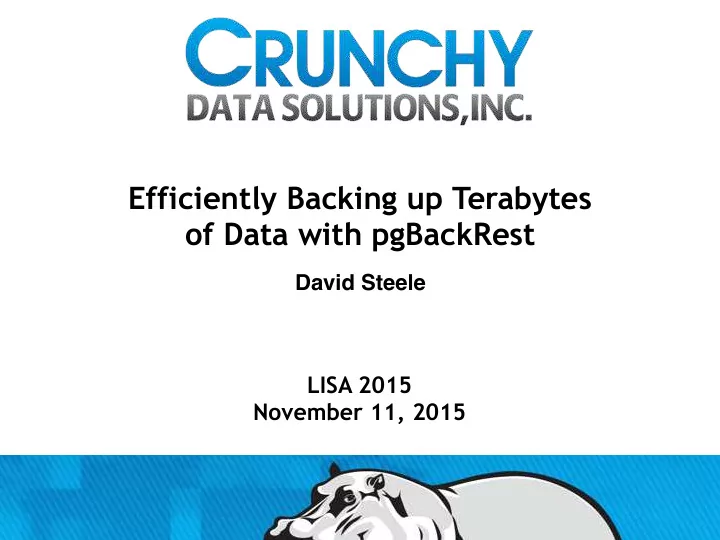

Efficiently Backing up Terabytes of Data with pgBackRest David Steele LISA 2015 November 11, 2015
About the Speaker • Senior Data Architect at Crunchy Data Solutions, the PostgreSQL company for secure enterprises. • Actively developing with PostgreSQL since 1999. 2
Agenda • Why Backup? • Living Backups • How to Backup? • pgBackRest Design • Performance • Demo 3
Why Backup? • Hardware Failure • No amount of redundancy can prevent it • Replication • WAL archive for when async streaming gets behind • Sync replica from backup instead of master • Corruption • Can be caused by hardware or software • Detection is of course a challenge • Accidents • So you dropped a table? • Deleted your most important account? 4
Why Backup? - Continued • Development • No more realistic data than production! • May not be practical due to size / privacy issues • Reporting • Use backups to standup an independent reporting server • Forensics • Recover important data that was removed on purpose 5
Schrödinger’s Backup The state of any backup is unknown until a restore is attempted. 6
Living Backups • Find a way to use your backups: Syncing / New Replicas • Offline reporting • Offline data archiving • Development • • Unused code paths will not work when you need them unless they are tested: Regularly scheduled automated failover using backups to • restore the old primary Regularly scheduled disaster recovery (during a main • window if possible) to test restore techniques 7
How to Backup? • pg_dump • pg_basebackup • Manual • ThirdParty • OmniPITR • Barman • WAL-E • pgBackRest? 8
pgBackRest Design - Say No to Rsync • Rsync powers many database backup solutions but it has some serious limitations: Single-threaded • One second timestamp resolution • No destination compression • Incremental backups require previous backup to • be uncompressed. • pgBackRest does not use rsync, tar or any other tools of that type: • Protocol supports local/remote operation • Solves timestamp resolution issue 9
pgBackRest Design - Features • Compression is performed and checksums are calculated in-stream • Asynchronous compression and transfer for WAL archiving • Remote or local operation • Threading for parallel compression and transfer • Full, differential, and incremental support • Backup and archive expiration policies • Resumable backups • Optional hard-linking of diff and incr backups • Works with PostgreSQL >= 8.3 10
pgBackRest Design - Backup Structure • Clear simple structure • Plaintext manifest • Valid Postgres data directory • Postgres can be started in the backup directory if no compression is used • Archive logs needed to make the backup consistent can optionally be copied to pg_xlog (no need to use recovery.conf or have access to the archive logs) 11
pgBackRest Performance vs Rsync Parameters PgBackRest Rsync threads: 1 141.0 seconds 124.5 seconds network compression: l3 destination compression: none .13X Faster threads: 2 84.1 seconds N/A network compression: l3 destination compression: none 1.48X Faster (than 1 rsync thread) threads: 1 334.4 seconds 510.3 seconds network compression: l6 destination compression: l6 1.52X Faster threads: 2 174.4 seconds N/A network compression: l6 destination compression: l6 2.93X Faster (than 1 rsync thread) 12
Do you think they backup? 13
Demo Time! • Live Demo, this will be fun… 14
Thank You! Questions? website: www.pgbackrest.org email: david@pgbackrest.org email: david@crunchydata.com release page: https://github.com/pgmasters/ backrest/releases slides & demo: https://github.com/dwsteele/ conference/releases 15
Recommend
More recommend